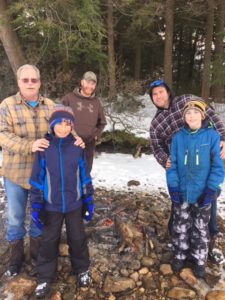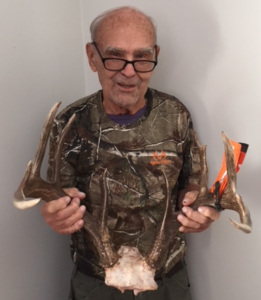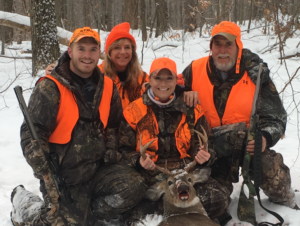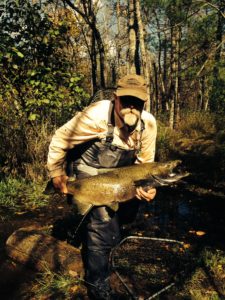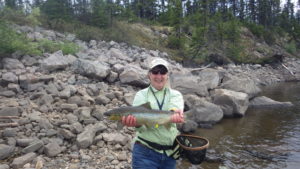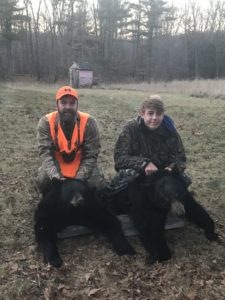MassWildlife reported that last year’s 13,220 deer harvest set a new state record. Archery and Primitive Firearms seasons also saw record harvests. The preliminary figures by season are as follows:
Youth Deer Hunt Day: 109, Paraplegic Deer Hunt: 4, Archery Season: 5,191, Shotgun Season: 5,162 and Primitive Firearms Season: 2,754. Note – This is the first year that the archery harvest is higher than the shotgun harvest. In the following chart, zones 1 through 4 represent the Western District.
2017 harvest by Wildlife Management Zone (WMZ map)
Zone Adult Male Female Button Buck Total
1 249 59 8 316
2 493 48 6 547
3 439 121 17 577
4N 425 95 19 539
4S 302 37 5 344
5 479 179 28 686
6 118 39 6 163
7 422 245 42 709
8 647 282 37 966
9 730 353 66 1,149
10 1,227 1,075 249 2,551
11 1,662 1,043 267 2,972
12 159 74 16 249
13 319 365 110 794
14 244 309 105 658
State 7,915 4,324 981 13,220
MassWildlife notes that while total harvest by zone can be informative, it doesn’t provide the complete picture for monitoring trends in deer density because total harvest is influenced by antlerless deer permit allocations in each zone as well as annual changes in hunter effort, weather, etc. The MassWildlife Deer Project Leader analyzes harvest, biological, and hunter effort data, along with hunter success rates, female versus male harvest, and other factors to manage deer populations in each zone. Such an analysis of this information is now underway for the annual spring deer management review. A complete harvest summary will be posted on the MassWildlife website shortly after the annual deer review, so we are encouraged to check back in June. Click onto the MassWildlife web site to learn more about deer management in Massachusetts.
Hunter Education Courses
MassWildlife sponsors other hunter education courses besides those that use shotguns, such as bowhunting and trapping courses. Unfortunately, neither of them is taught here in the Western District and for that reason I have not been listing them in this column. However; some local sportsmen may be interested in taking these courses and are willing to travel. Therefore:
Bowhunting – There will be a one-day bowhunter education course on March 18 from 8 AM to 5 PM at the Swift River Sportsmen’s Club, 350 Cold Spring Road Belchertown. To view this listing and others, and obtain driving directions, visit the web at: https://www.mass.gov/service-details/bowhunter-education-course-offerings. As a reminder, all courses are free of charge and all necessary course materials will be provided to the student. Unaccompanied minors will need to bring a signed permission form to class in order to participate. This form can be downloaded and printed at https://www.mass.gov/files/documents/2017/10/10/2017%20Minor%20Permission%20fom.pdf
A bowhunter education certificate does not qualify you to purchase a Massachusetts Hunting license. If you are preparing to buy your first ever hunting license, you need to complete Basic Hunter Education (https://www.mass.gov/service-details/basic-hunter-education-course-offerings) even if you plan on hunting only with archery equipment.
If you are planning on hunting outside of the commonwealth, a Massachusetts Bowhunter Education Certificate is accepted in other jurisdictions that do mandate the successful completion a bowhunter course to hunt with archery equipment. If you have any questions, contact MassWildlife at (508) 389-7820, Monday through Friday from 8 AM to 4 PM.
Trapping – A Trapper Education Course with Independent Study will be held at the Auburn Sportsmen’s Club, 50 Elm Street, Auburn, MA on March 21 and 31at the following times: 3/21 from 6:30 PM to 9:30 PM and on 3/31 from 8 AM to 5 PM. You must attend all class dates and times to successfully complete this course. This course is being offered in the Independent Study format which means that in addition to the 2 required in-class sessions, students will need to complete homework in between the 2 class sessions.
If you are interested in this course and wish to enroll, call (508) 389-7830 immediately between 8 AM. and 4 PM, Monday through Friday. Students are enrolled first-come, first-served, and courses fill quickly.
Department of Ecological Restoration news
Many Massachusetts rivers lack enough water at certain times of year to support aquatic ecosystems, fishing, recreation and adequate drinking supplies. DER, which is a division reportable to the Commissioner of Fish & Wildlife, works to restore natural streamflow (the amount of water that flows through streams and rivers) in Massachusetts. They do this by working with partners to collect streamflow data; to inform and support policy and actions that restore and maintain healthy streamflows and by managing restoration projects aimed at restoring natural flow. In 2018, the DER:
• Leveraged over $6.5 million in newly awarded external funds for community-based restoration projects. The grant funds will pay for engineering, design, and construction work taking place in communities across the Commonwealth.
• Provided technical support to municipal staff, watershed groups, landowners, and other organizations in more than 193 communities across 26 major watersheds.
• Supervised volunteer workers in 90 communities, devoting more than $70,000 worth of labor towards protecting and restoring our rivers and wetlands.
• Worked with more than 30 partners, DER removed 7 dams, opening up more than 40 river miles, restoring 30 acres of wetlands, and reconnecting more than 900 acres of spawning habitat.
• Signed Cooperative Agreements with Sponsors of 11 new Priority Projects and began project scoping and planning. The projects include dam removals, culvert replacements, urban river revitalization efforts, floodplain enhancement, and streamflow restoration.
• Published an on-line dam removal decision support tool for use by federal, state, and local partners. The tool evaluates the expected ecological benefits of removing any known dam in the Commonwealth.
• Launched its new Culvert Replacement Municipal Assistance Program by awarding $905,000 in grants to 13 towns for projects that replace undersized culverts.
• Piloted a community-based social marketing program in the Ipswich River Watershed to encourage voluntary reductions in residential water use
A local project is occurring in the Town of Washington. Aging infrastructure coupled with intense rain events over the last 10 years caused several culverts in town, including the culvert on Frost Road over Savery Brook to begin to fail. In recent storms, this culvert became completely blocked, causing Savery Brook to overtop the road. Savery Brook is part of the National Wild & Scenic Rivers system and supports native brook trout. Replacing this failing culvert with a larger, safer structure will restore access to this important headwater stream while alleviating a flood hazard.
Incidentally, on January 3, Department of Fish and Game Commissioner Ronald Amidon appointed Beth Lambert to lead the DER. Beth brings twenty years of experience and strong partner relationships to her new leadership role. For the past four years Beth has managed DER’s Aquatic Habitat Restoration Program, overseeing the Division’s river, wetland, and salt marsh restoration projects across the Commonwealth. Previously, Beth managed the River Restoration Program for DER and the former Riverways Program. Prior to that, she worked for the New Hampshire Coastal Program as the Habitat Restoration Coordinator; for Oregon Sea Grant/ Oregon State University Extension as Watershed Management Extension faculty; and as a stream ecologist for a non-profit organization in Homer, Alaska.
Beth is no stranger to the Berkshires having work with the Housatonic Valley Association, the Berkshire Environmental Action Team (BEAT) and the Taconic and Hoosic Chapters of Trout Unlimited on stream continuity and other watershed projects.
Opportunities to learn about our furry and hairy critters
On Friday, February 16, at 6:30 PM, Sue Morse, the founder of Keeping Track® , will give a presentation entitled “Bear with US! Living with Bears in the North Country”. The presentation will take place at the Boland Theater at Berkshire Community College in Pittsfield. Be prepared for lots of fascinating information on black bear biology and ecology, with emphasis on the field identification of tracks and sign. This show offers the most comprehensive discussion of bear scent-marking behaviors, illustrated with dozens of her original images. As for living in harmony with black bears, it’s entirely up to us, as this program will solidly demonstrate. “Bear safety” is achieved largely because of what we do out there, whether it be in the wild or around our home and farmyard. It is more about what we can do to minimize the hazards we pose to bears.
On Saturday, February 17 from 9 AM to 12 Noon and from 1 to 4 PM Sue Morse will conduct a tracking workshop at the Myrin Preserve in Great Barrington, MA. She has over forty years of experience interpreting wildlife habitat uses. She is highly regarded as an expert in natural history and one of the top wildlife trackers in North America. Since 1977, she has been monitoring wildlife, with an emphasis on documenting the presence and habitat requirements of bobcat, black bear, Canada lynx and cougar.
Learn how to apply scientific knowledge about the habits and habitats of various wildlife and to predict where to look for sign. In the field you will learn “search imaging” as well as Keeping Track’s scientific documentation methods for photographing tracks and sign.
Meet and Carpool from Monument Mountain High School – 600 Stockbridge Rd, Great Barrington MA 01230. The cost is $25/person ($20 if member in BEAT’s tracking club)
RSVP Required, Space Limited. Contact Elia Del Molino at BEAT to sign up!
elia@thebeatnews.org or 413-429-6416.
Then on Saturday evening, February 17, from 6 to 8 PM, Sue will give a presentation entitled The Mysterious Mustelids. (She is going to be a busy gal that weekend!) Learn why fishers aren’t cats and ermine aren’t evil. Mustelids are the largest and most diverse order of carnivores on Planet Earth. The presentation, will take place at Monument Mountain High School Auditorium, 600 Stockbridge Rd., Great Barrington, MA.
Sue Morse’s evening presentations are free and open to the public. They are sponsored by: Trustees of Reservation, BEAT, MassAudubon, Sheffield Land Trust, Nature Conservancy, NE Forestry Foundation, Berkshire Natural Resources Council, Great Barrington Land Conservancy and Green Berkshires.
On Tuesday, February 20, from 5:15 to 7 PM, the Berkshire Environmental Action Team (BEAT) Pittsfield Green Drinks will present a program entitled Getting to Know Our Neighbors: Berkshire Wildlife On Foot and By Camera. It will take place at the J. Allen’s Clubhouse Grille, 41 North Street, Pittsfield and will feature Elia Del Molino, Stewardship Manager for BEAT. Elia will give a presentation on getting to know wildlife of the Berkshire hills through tracking and trail cameras. Elia manages BEAT’s tracking club, a group of locals who bushwhack through forests and fields looking for evidence of wildlife, mostly mammals. Elia will discuss some of their exploits and show a compilation of wildlife videos from BEAT’s remote cameras.
Pittsfield Green Drinks is an informal gathering on the third Tuesday of the month. The gatherings are open to everyone with any environmental interest. Incidentally, the drinks aren’t green but the conversations are. Pittsfield Green Drinks is sponsored by BEAT. For more information about Pittsfield Green Drinks, contact Elizabeth Orenstein elizabeth@thebeatnews.org or (413) 717-1255.


